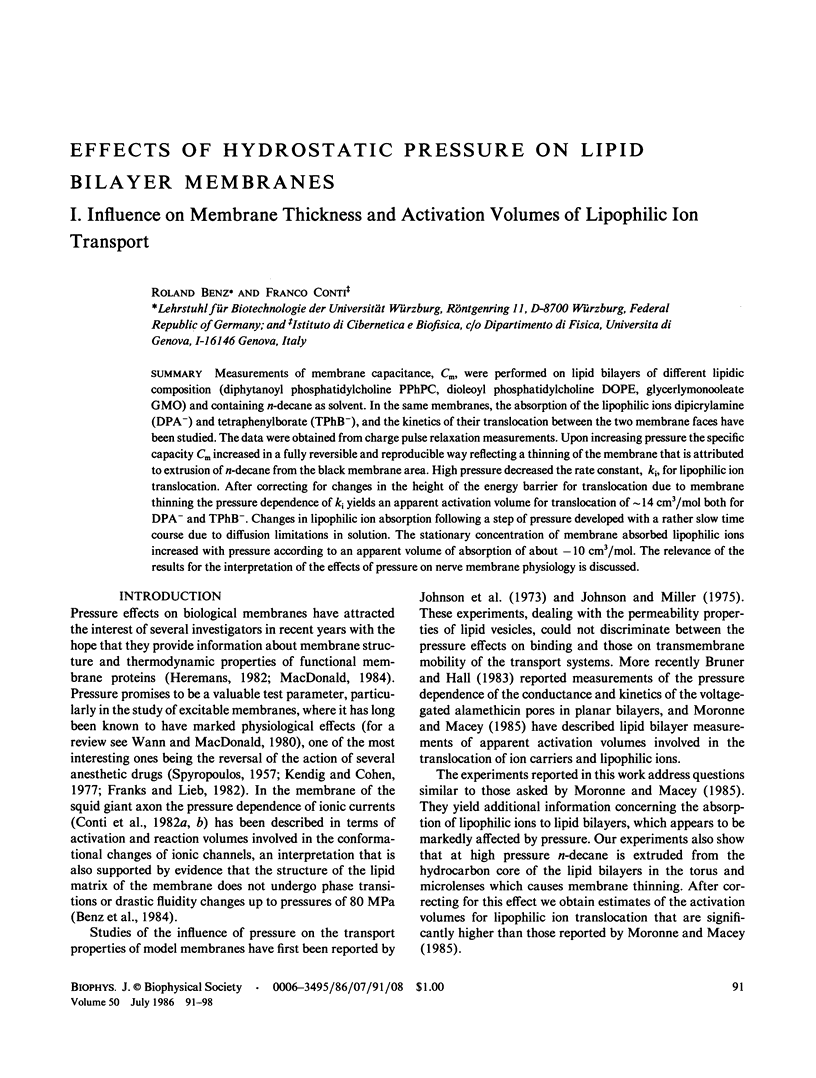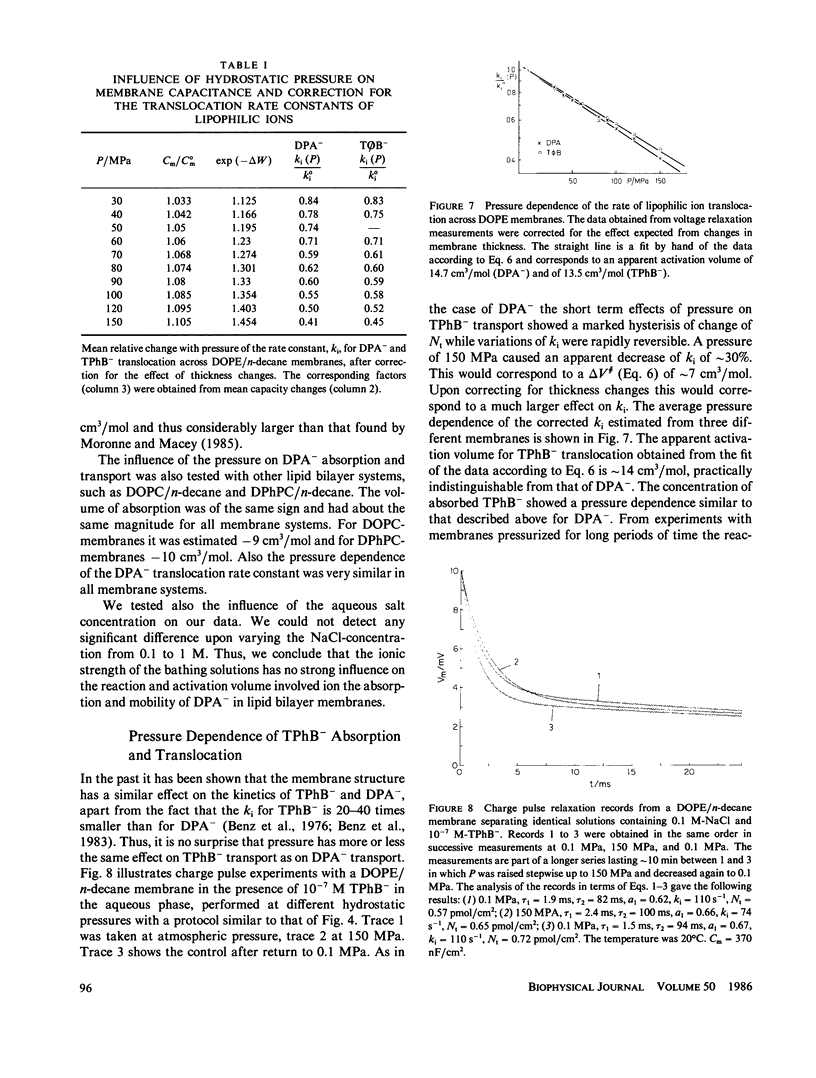Abstract
Measurements of membrane capacitance, Cm, were performed on lipid bilayers of different lipidic composition (diphytanoyl phosphatidylcholine PPhPC, dioleoyl phosphatidylcholine DOPE, glycerylmonooleate GMO) and containing n-decane as solvent. In the same membranes, the absorption of the lipophilic ions dipicrylamine (DPA-) and tetraphenylborate (TPhB-), and the kinetics of their translocation between the two membrane faces have been studied. The data were obtained from charge pulse relaxation measurements. Upon increasing pressure the specific capacity Cm increased in a fully reversible and reproducible way reflecting a thinning of the membrane that is attributed to extrusion of n-decane from the black membrane area. High pressure decreased the rate constant, ki, for lipophilic ion translocation. After correcting for changes in the height of the energy barrier for translocation due to membrane thinning the pressure dependence of ki yields an apparent activation volume for translocation of approximately 14 cm3/mol both for DPA- and TPhB-. Changes in lipophilic ion absorption following a step of pressure developed with a rather slow time course due to diffusion limitations in solution. The stationary concentration of membrane absorbed lipophilic ions increased with pressure according to an apparent volume of absorption of about -10 cm3/mol. The relevance of the results for the interpretation of the effects of pressure on nerve membrane physiology is discussed.
Full text
PDF







Images in this article
Selected References
These references are in PubMed. This may not be the complete list of references from this article.
- Benz R., Conti F., Fioravanti R. Extrinsic charge movement in the squid axon membrane. Effect of pressure and temperature. Eur Biophys J. 1984;11(1):51–59. doi: 10.1007/BF00253858. [DOI] [PubMed] [Google Scholar]
- Benz R., Conti F. Structure of the squid axon membrane as derived from charge-pulse relaxation studies in the presence of absorbed lipophilic ions. J Membr Biol. 1981 Apr 15;59(2):91–104. doi: 10.1007/BF01875707. [DOI] [PubMed] [Google Scholar]
- Benz R., Fröhlich O., Läuger P. Influence of membrane structure on the kinetics of carrier-mediated ion transport through lipid bilayers. Biochim Biophys Acta. 1977 Feb 4;464(3):465–481. doi: 10.1016/0005-2736(77)90023-2. [DOI] [PubMed] [Google Scholar]
- Benz R., Gisin B. F. Influence of membrane structure on ion transport through lipid bilayer membranes. J Membr Biol. 1978 Jun 9;40(4):293–314. doi: 10.1007/BF01874161. [DOI] [PubMed] [Google Scholar]
- Benz R., Hallmann D., Poralla K., Eibl H. Interaction of hopanoids with phosphatidylcholines containing oleic and omega-cyclohexyldodecanoic acid in lipid bilayer membranes. Chem Phys Lipids. 1983 Dec;34(1):7–24. doi: 10.1016/0009-3084(83)90056-7. [DOI] [PubMed] [Google Scholar]
- Benz R., Janko K. Voltage-induce capacitance relaxation of lipid bilayer membranes. Effects of membrane composition. Biochim Biophys Acta. 1976 Dec 14;455(3):721–738. doi: 10.1016/0005-2736(76)90043-2. [DOI] [PubMed] [Google Scholar]
- Benz R., Läuger P., Janko K. Transport kinetics of hydrophobic ions in lipid bilayer membranes. Charge-pulse relaxation studies. Biochim Biophys Acta. 1976 Dec 14;455(3):701–720. doi: 10.1016/0005-2736(76)90042-0. [DOI] [PubMed] [Google Scholar]
- Benz R., Läuger P. Transport kinetics of dipicrylamine through lipid bilayer membranes. Effects of membrane structure. Biochim Biophys Acta. 1977 Jul 14;468(2):245–258. doi: 10.1016/0005-2736(77)90118-3. [DOI] [PubMed] [Google Scholar]
- Benz R., Stark G., Janko K., Läuger P. Valinomycin-mediated ion transport through neutral lipid membranes: influence of hydrocarbon chain length and temperature. J Membr Biol. 1973;14(4):339–364. doi: 10.1007/BF01868084. [DOI] [PubMed] [Google Scholar]
- Benz R., Zimmermann U. Evidence for the presence of mobile charges in the cell membrane of Valonia utricularis. Biophys J. 1983 Jul;43(1):13–26. doi: 10.1016/S0006-3495(83)84318-5. [DOI] [PMC free article] [PubMed] [Google Scholar]
- Bruner L. J., Hall J. E. Pressure effects on alamethicin conductance in bilayer membranes. Biophys J. 1983 Oct;44(1):39–47. doi: 10.1016/S0006-3495(83)84275-1. [DOI] [PMC free article] [PubMed] [Google Scholar]
- Conti F., Fioravanti R., Malerba F., Wanke E. A comparative analysis of extrinsic fluorescence in nerve membranes and lipid bilayers. Biophys Struct Mech. 1974 Oct 28;1(1):27–45. doi: 10.1007/BF01022558. [DOI] [PubMed] [Google Scholar]
- Conti F., Fioravanti R., Segal J. R., Stühmer W. Pressure dependence of the potassium currents of squid giant axon. J Membr Biol. 1982;69(1):35–40. doi: 10.1007/BF01871239. [DOI] [PubMed] [Google Scholar]
- Conti F., Fioravanti R., Segal J. R., Stühmer W. Pressure dependence of the sodium currents of squid giant axon. J Membr Biol. 1982;69(1):23–34. doi: 10.1007/BF01871238. [DOI] [PubMed] [Google Scholar]
- Conti F., Inoue I., Kukita F., Stühmer W. Pressure dependence of sodium gating currents in the squid giant axon. Eur Biophys J. 1984;11(2):137–147. doi: 10.1007/BF00276629. [DOI] [PubMed] [Google Scholar]
- Dilger J. P., Benz R. Optical and electrical properties of thin monoolein lipid bilayers. J Membr Biol. 1985;85(2):181–189. doi: 10.1007/BF01871270. [DOI] [PubMed] [Google Scholar]
- Evans E. A., Simon S. Mechanics of electrocompression of lipid bilayer membranes. Biophys J. 1975 Aug;15(8):850–852. doi: 10.1016/S0006-3495(75)85860-7. [DOI] [PMC free article] [PubMed] [Google Scholar]
- Franks N. P., Lieb W. R. Molecular mechanisms of general anaesthesia. Nature. 1982 Dec 9;300(5892):487–493. doi: 10.1038/300487a0. [DOI] [PubMed] [Google Scholar]
- Haydon D. A., Kimura J. E. Some effects of n-pentane on the sodium and potassium currents of the squid giant axon. J Physiol. 1981 Mar;312:57–70. doi: 10.1113/jphysiol.1981.sp013615. [DOI] [PMC free article] [PubMed] [Google Scholar]
- Heremans K. High pressure effects on proteins and other biomolecules. Annu Rev Biophys Bioeng. 1982;11:1–21. doi: 10.1146/annurev.bb.11.060182.000245. [DOI] [PubMed] [Google Scholar]
- Johnson S. M., Miller K. W., Bangham A. D. The opposing effects of pressure and general anaesthetics on the cation permeability of liposomes of varying lipid composition. Biochim Biophys Acta. 1973 Apr 25;307(1):42–57. doi: 10.1016/0005-2736(73)90023-0. [DOI] [PubMed] [Google Scholar]
- Johnson S. M., Miller K. W. The effect of pressure and the volume of activation on the monovalent cation and glucose permeabilities of liposomes of varying composition. Biochim Biophys Acta. 1975 Jan 28;375(2):286–291. doi: 10.1016/0005-2736(75)90196-0. [DOI] [PubMed] [Google Scholar]
- Kendig J. J., Cohen E. N. Pressure antagonism to nerve conduction block by anesthetic agents. Anesthesiology. 1977 Jul;47(1):6–10. [PubMed] [Google Scholar]
- Liu N. I., Kay R. L. Redetermination of the pressure dependence of the lipid bilayer phase transition. Biochemistry. 1977 Jul 26;16(15):3484–3486. doi: 10.1021/bi00634a030. [DOI] [PubMed] [Google Scholar]
- Low P. S., Somero G. N. Activation volumes in enzymic catalysis: their sources and modification by low-molecular-weight solutes. Proc Natl Acad Sci U S A. 1975 Aug;72(8):3014–3018. doi: 10.1073/pnas.72.8.3014. [DOI] [PMC free article] [PubMed] [Google Scholar]
- Macdonald A. G. The effects of pressure on the molecular structure and physiological functions of cell membranes. Philos Trans R Soc Lond B Biol Sci. 1984 Jan 7;304(1118):47–68. doi: 10.1098/rstb.1984.0008. [DOI] [PubMed] [Google Scholar]
- Moronne M., Macey R. I. Apparent activation volumes of hydrophobic ions and carriers in planar lipid bilayers. J Membr Biol. 1985;84(3):221–227. doi: 10.1007/BF01871385. [DOI] [PubMed] [Google Scholar]
- Parsegian A. Energy of an ion crossing a low dielectric membrane: solutions to four relevant electrostatic problems. Nature. 1969 Mar 1;221(5183):844–846. doi: 10.1038/221844a0. [DOI] [PubMed] [Google Scholar]
- SPYROPOULOS C. S. The effects of hydrostatic pressure upon the normal and narcotized nerve fiber. J Gen Physiol. 1957 Jul 20;40(6):849–857. doi: 10.1085/jgp.40.6.849. [DOI] [PMC free article] [PubMed] [Google Scholar]
- Stamatoff J., Guillon D., Powers L., Cladis P., Aadsen D. X-ray diffraction measurements of dipalmitoylphosphatidylcholine as a function of pressure. Biochem Biophys Res Commun. 1978 Nov 29;85(2):724–728. doi: 10.1016/0006-291x(78)91221-4. [DOI] [PubMed] [Google Scholar]
- White S. H. The lipid bilayer as a "solvent" for small hydrophobic molecules. Nature. 1976 Jul 29;262(5567):421–422. doi: 10.1038/262421a0. [DOI] [PubMed] [Google Scholar]
- Wulf J., Benz R., Pohl W. G. Properties of bilayer membranes in the presence of dipicrylamine. A comparative study by optical absorption and electrical relaxation measurements. Biochim Biophys Acta. 1977 Mar 17;465(3):429–442. doi: 10.1016/0005-2736(77)90262-0. [DOI] [PubMed] [Google Scholar]



